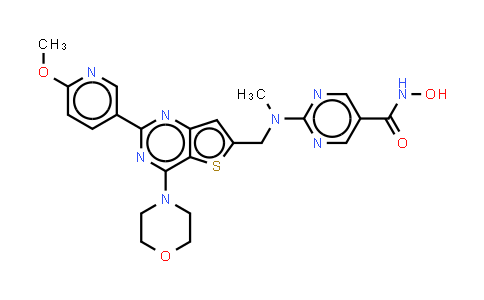| Chemical Name |
Fimepinostat |
| CAS Number |
1339928-25-4 |
| MDL Number |
MFCD22420823 |
| Molecular Formula |
C23H24N8O4S |
| Molecular Weight |
508.55 |
| Synonyms |
CUDC-907 |
Introduction of 1339928-25-4 :
Fimepinostat (CUDC-907) potently inhibits class I PI3Ks as well as classes I and II HDAC enzymes with an IC50 of 19/54/39 nM and 1.7/5.0/1.8/2.8 nM for PI3Kα/PI3Kβ/PI3Kδ and HDAC1/HDAC2/HDAC3/HDAC10 , respectively. IC50 & Target: IC50: 1.7/5.0/1.8/2.8 nM (HDAC1/2/3/10), 19/54/39 nM (PI3Kα/β/δ)[1] In Vitro: Fimepinostat is a potent pan-inhibitor of HDAC classes I and II enzymes and observed that its potency against class I HDACs is similar to that of LBH589 and greater than that of SAHA. Fimepinostat is also a potent inhibitor of class I PI3K kinases with an IC50 of 19, 54, and 39 nM for PI3Kα, PI3Kβ, and PI3Kδ, respectively. Fimepinostat markedly induces p21 protein in H460, a non-small cell lung cancer (NSCLC) cell line. Fimepinostat causes the reduction of both p-STAT3 (Y-705) and p-SRC in RPMI-8226 multiple myeloma cells and reduces both phosphorylated and total protein levels of MET and EGFR as well as HER2 and HER3 in H1975 NSCLC cells and BT-474 breast cancer cells, respectively. Fimepinostat induces caspase-3 and -7 activation in HCT-116 colon cancer cells in a dose-dependent manner. Fimepinostat potently inhibits the growth of cancer cells derived from both hematologic and solid tumors. Fimepinostat potently inhibits the proliferation of cells expressing either mutant or wild-type PI3K[1]. In Vivo: Oral administration of Fimepinostat inhibits growth of the Daudi cancer cell xenografts in a dose-dependent manner. Tumor stasis is observed at 100 mg/kg in this model without obvious toxicity. Importantly, in the same model, Fimepinostat achieves better efficacy than GDC-0941, SAHA, or a combination of these 2 compounds given at their maximal tolerated doses (MTD). Furthermore, Fimepinostat causes tumor regression or stasis after intravenous (50 mg/kg) or oral administration (100 mg/kg) in a xenograft tumor model of SU-DHL4 diffuse large B-cell lymphoma (DLBCL) and causes tumor stasis in KRAS-mutant A549 NSCLC cell xenografts[1].
| Purity |
NLT 98% |
| Storage |
at 20ºC 2 years |
*The above information is for reference only.
